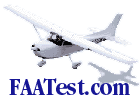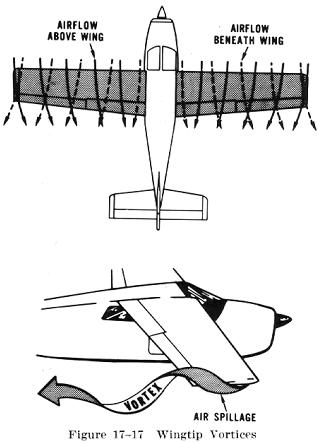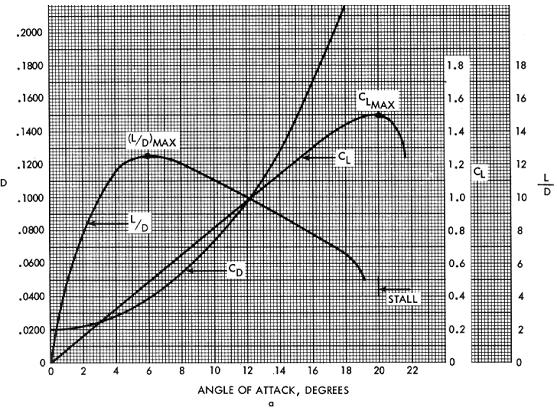| Drag
Drag in flight is of two basic types: parasite drag and induced
drag. The first is called parasite because it in no way functions to aid flight
while the second is induced or created as a result of the wing developing lift.
Parasite drag is composed of two basic elements: form drag,
resulting from the disruption of the streamline flow; and the resistance of skin
friction.
Of the two components of parasite drag, form drag is the easier
to reduce when designing an airplane. In general, a more streamlined object
produces the best form to reduce parasite drag.
Skin friction is the type of parasite drag that is most
difficult to reduce. No surface is perfectly smooth. Even machined surfaces,
when inspected through magnification, have a ragged, uneven appearance. This
rough surface will deflect the streamlines of air on the surface, causing
resistance to smooth airflow. Skin friction can be minimized by employing a
glossy, flat finish to surfaces, and by eliminating protruding rivet heads,
roughness, and other irregularities.
Another element must be added to the consideration of parasite
drag when designing an airplane. This drag combines the effects of form drag and
skin friction and is called interference drag. If we place two objects adjacent
to one another the resulting turbulence produced may be 50 to 200 percent
greater than the parts tested separately.
The three elements, form drag, skin friction, and interference
drag, are all computed to determine parasite drag on an airplane.
Shape of an object is a big factor in parasite drag. However,
indicated airspeed is an equally important factor when speaking of parasite
drag. The profile drag of a streamlined object held in a fixed position relative
to the airflow increases approximately as the square of the velocity; thus,
doubling the airspeed increases the drag four times, and tripling the airspeed
increases the drag nine times. This relationship, however, holds good only at
comparatively low subsonic speeds. At some higher airspeeds the rate at which
profile drag has been increased with speed suddenly begins to increase more
rapidly.
The second basic type of drag is induced drag. It is an
established physical fact that no system which does work in the mechanical sense
can be 100% efficient. This means that whatever the nature of the system, the
required work is obtained at the expense of certain additional work that is
dissipated or lost in the system. The more efficient the system the smaller this
loss.
In level flight the aerodynamic properties of the wing
produce a required lift, but this can be obtained only at the expense of a
certain penalty. The name given to this penalty is induced drag. Induced drag is
inherent whenever a wing is producing lift and, in fact, this type of drag is
inseparable from the production of lift. Consequently, it is always present if
lift is produced.
| The wing produces the lift force by making use of the energy of the
free airstream. Whenever the wing is producing lift we have seen that the
pressure on the lower surface of the wing is greater than that on the
upper surface. As a result, the air tends to flow from the high pressure
area below the wingtip upward to the low pressure area above the wing. In
the vicinity of the wingtips there is a tendency for these pressures to
equalize, resulting in a lateral flow outward from the underside to the
upper surface of the wing. This lateral flow imparts a rotational velocity
to the air at the wingtips and trails behind the wing. Therefore, flow
about the wingtips will be in the form of two vortices trailing behind as
the wings move on.
When the airplane is viewed from the tail, these vortices
will circulate counterclockwise about the right wingtip and clockwise
about the left wingtip (Fig. 17-17). Bearing in mind the direction of
rotation of these vortices, it can be seen that they induce an upward flow
of air beyond the wingtip, and a downwash flow behind the wing's trailing
edge. This induced downwash has nothing in common with the downwash that
is necessary to produce lift. It is, in fact, the source of induced drag.
The greater the size and strength of the vortices and consequent downwash
component on the net airflow over the wing, the greater the induced drag
effect becomes.
This downwash over the top of the wing at the tip has the same effect
as bending the lift vector rearward; therefore, the lift is slightly aft
of perpendicular to the relative wind, creating a rearward lift component.
This is induced drag. |
|
 |
It should be remembered also that in order to create a greater
negative pressure on the top of the wing, the wing can be inclined to a
higher angle of attack; also, that if the angle of attack of an
asymmetrical wing were zero, there would be no pressure differential and
consequently no downwash component; therefore, no induced drag. In any
case, as angle of attack increases, induced drag increases proportionally.
To state this another way - the lower the airspeed the greater the
angle of attack required to produce lift equal to the airplane's weight
and consequently, the greater will be the induced drag. The amount of
induced drag varies inversely as the square of the airspeed.
From the foregoing discussion we have seen that parasite drag increases
as the square of the airspeed, and induced drag varies inversely as the
square of the airspeed. It can be seen that as airspeed decreases to near
the stalling speed the total drag becomes greater, due mainly to the sharp
rise in induced drag. Similarly, as the airspeed reaches the terminal
velocity of the airplane, the total drag again increases rapidly, due to
the sharp increase of parasite drag. As we can see in Figure 17-18 at some
given airspeed, total drag is at its maximum amount.
This | is very important in figuring the
maximum endurance and range of airplanes, for when drag is at a minimum, power
required to overcome drag is also at a minimum. The drag factors will play an
important part in a later section on airplane performance.
| To understand the effect of lift and drag on an
airplane in flight we must combine them and consider the lift/drag ratio.
With the lift and drag data available for various airspeeds of the
airplane in steady, unaccelerated flight, the proportions of CL
(Coefficient of Lift) and CD (Coefficient of Drag) can be calculated for
each specific angle of attack. The resulting plot for lift/drag ratio with
angle of attack shows that L/D increases to some maximum then decreases at
the higher lift coefficients and angles of attack, as shown in Fig. 17-10.
Note that the maximum lift/drag ratio, (L/D max) occurs at one specific
angle of attack and lift coefficient. If the airplane is operated in
steady flight at L/D |
| max, the total drag is at a
minimum. Any angle of attack lower or higher than that for L/D max reduces the
lift/drag ratio and consequently increases the total drag for a given airplane's
lift.
The location of the center of gravity (CG) is determined by
the general design of each particular airplane. The designers determine how far
the center of pressure (CP) will travel. They then fix the center of gravity
forward of the center of pressure for the corresponding flight speed in order to
provide an adequate restoring moment to retain flight equilibrium.
The configuration of an airplane has a great effect on the
lift/drag ratio. The high performance sailplane may have extremely high
lift/drag ratios. The supersonic fighter may have seemingly low lift/drag ratios
in subsonic flight, but the airplane configurations required for supersonic
flight (and high L/Ds at high Mach numbers) cause this situation.
 |
FAATest.com
- Aviation Library
Dauntless
Software hosts and maintains this library as a service to pilots
and aspiring pilots worldwide. Click
here for ways to show your appreciation for this service.
While much of this material comes from the FAA, parts of it are (c) Dauntless Software, all rights reserved. Webmasters: please
do not link directly to individual books in this library--rather,
please link to our main web page at www.dauntless-soft.com or
www.faatest.com. Thanks! |
|



